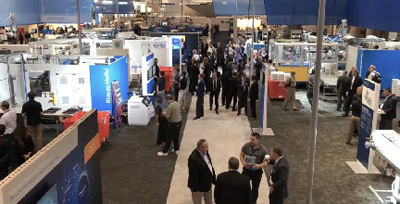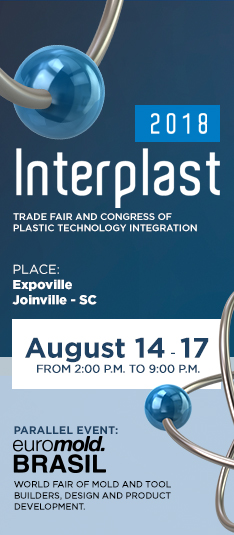| Plastics News |
KraussMaffei at NPE: Efficient injection molding machines and Industry 4.0 solutions setting trends for the future
May, 07, 2018 - At NPE in Orlando, KraussMaffei highlighted its market position in North America as a system provider for premium quality injection molding machines, automation and intelligent Industry 4.0 solutions from a single source. The GX 900 with the new speed option is a solution for the large packaging market. The GXW 450 FiberForm system with multicomponent technology was also premiering at NPE. It offers new areas of potential for thermoplastic fiber-reinforced lightweight construction. Other highlights at the KraussMaffei booth included the all-electric PX 51, used in LSR processing, and the hydraulic CX 200 with inductive mold heat-balancing. "We are using the slogan 'our people help shape your success' to showcase groundbreaking injection molding and automation solutions at NPE. We help our customers achieve more efficiency and cost-effectiveness over the long term using our flexible standard machines and customized system solutions. The primary target group of our exhibits at NPE consists of the automotive, packaging, construction, medical and electronics industries," explains Paul Caprio, President of US subsidiary Krauss-Maffei Corporation in Florence, KY. A total of seven KraussMaffei injection molding machines with automation technology were live in production at the KraussMaffei trade show booth and at partner booths. Making packaging faster In addition to high injection speeds, the primary requirement for thin wall articles for packaging and logistics solutions are short cycles. For this reason, KraussMaffei has added a new speed option to its 2-platen GX series which offers customers an optional choice of different injection speeds of up to 700 mm/s depending on the injection unit. The GX 900-12000 at NPE also included faster clamping speeds of up to 0.45 s according to EUROMAP. "The GX with the speed option features an efficient, cost-effective and attractive alternative to manufacturing large components for the packaging and logistics industries – a market that has undergone continuous growth in the USA in recent years," says Caprio. According to Krauss Maffei, the speed option really showcases its advantages at opening widths of 350 to 400 mm. In this way, the kinematic unit is similar to comparable toggle machines that also do not reach their maximum acceleration until the opening strokes are large. Enhanced parallel movements on the plasticizing side with the electrically driven plasticizing unit (E-Plast) support the short cycle times, the manufacturer claims. PowerPack III features additional speed options such as a faster clamping force build-up, screw decompression or injection unit movement, Krauss Maffei says. At NPE, the GX 900-12000 produced large 20 L buckets in a 2-cavity mold in an in-mold labeling process (IML), in short cycle times of less than 14 seconds. The GX 900 also featured the KraussMaffei HPS barrier screw, which enables fast melting and high shot weights. Overall, the throughput can be increased by up to 12 percent, Krauss Maffei claims. "The IML application at NPE is the market debut for the GX series speed option. At the same time, a 20 L bucket is being produced in a 2-cavity mold using the IML process," says Caprio. Until now, these large buckets had mostly been printed. The speed option now enables these buckets to be produced cost-effectively in the IML process. Combination of FiberForm with multicomponent technology At NPE, KraussMaffei was debuting a FiberForm application in combination with swivel plate technology for multi-component injection molding on a GXW 450-2000/1400. "This combination can be used to create completely new visual and haptic component features for thermoplastic composites in a single process. Thanks to the TPE component, the center armrest produced at NPE has functional parts and visible parts with surfaces that are extremely soft and visually appealing, which increases comfort and visual aesthetics in the vehicle interior. In turn, the use of the composite sheet increases the rigidity and strength of the component. This means that the reinforcing ribs and component itself are made with thinner walls, which reduces their weight", says Caprio. " FiberForm combines the thermoforming of composite sheets and injection molding in a single process. This process results in fiber-reinforced plastic components that are particularly lightweight yet feature a high level of strength. They are used primarily in vehicle manufacturing. “Our groundbreaking FiberForm system is second to none when it comes to lightweight production using fiber-reinforced plastic components. Our customers appreciate the high quality, reliability and cost-efficiency when manufacturing fiber-reinforced lightweight components in large quantities and fast cycle times. Intelligent automation solutions and heating technology optimized for the injection molding process support short cycle times of fewer than 60 seconds", explains Caprio. PX 51-55: LSR processing Silicones or LSRs (liquid silicon rubbers) are also on the rise in the USA. The medical technology and automotive industries, in particular, are becoming increasingly interested in the outstanding physical and chemical properties of the material. However, the material has an extremely low viscosity, especially highly transparent silicone, and it requires especially high precision during injection. The PX 51-55 SilcoSet at NPE features a hydraulic nozzle contact force with an electric injection unit. According to Krauss Maffei, this combination makes the process safe and precise. It says that special screw seals on the shaft support this argument, and, additionally, the spring-loaded return-flow lock of the screw guarantees reproducible closing behavior when processing such low-viscosity material. The PX 51-55 SilcoSet, which was producing special dosing caps (duckbills) for the medical industry at NPE, is part of the new, all-electric injection molding machine series from KraussMaffei. "The PX series combines the advantages of an all-electric injection molding machine with maximum modularity. Our customers appreciate the high degree of variety and flexibility, both in configuring the right machine, for example, using our wide range of clamping unit and injection unit combinations, and in production or retrofitting. For example, the PX 51-55 at NPE featured larger platens for the next level of clamping force. The larger clearance corresponds to an increased maximum mold weight. This makes it possible to install a larger mold, even at a clamping force of 500 kN. Large clamping units, small injection units – in production, this means that no more space is taken up than what is required for the production order, adds Caprio". CX 200-750: More freedom in design thanks to inductive mold heat-balancing At NPE, a CX 200-750 with inductive mold heat-balancing created impressive surface effects together with Roctool (HD plastics) without additional post-mold processing. "The design options in the technology are immense. Whether it is shades of colors, hologram, glossy or matte effects, everything can be done in the one-shot process without additional post-mold processing such as film decoration or (secondary) painting," says Caprio. At NPE, the CX 200 with a 16-cavity mold produced 16 different surfaces (design variants) of a plastic housing for a game console. The CX 200 from KraussMaffei includes, for example, the drive concept according to state-of-the-art technology (IE3 types) as well as the energy-efficient BluePower servo drive. An active accumulator management system completes the overall concept. As a two-platen machine, the CX series requires less installation area than longer three-platen models. Under the clamping unit, it provides space for peripheral devices and all kinds of demolding systems. During NPE, an LRX 150 of the new generation of linear robots was demolding the components. In the next step, the component and the sprue were separated. Finally, the bagging and packaging were carried out. Thanks to the space-saving design, this can be completed within the protective enclosure and saves on the footprint required for infeed. Plastics 4.0 Industry 4.0, Internet of Things or just the networking of machines and production processes: KraussMaffei was advancing this development under the umbrella term "Plastics 4.0" and presenting solutions at NPE that can help customers increase their productivity and efficiency in the long term. "This fourth industrial (r)evolution will radically change the working world. One example is automatic optimization of intelligent machines, which ensures that processes are stable. This includes the KraussMaffei APC plus (Adaptive Process Control) intelligent machine function, which can be used to quickly compensate for disruptive fluctuations and environmental influences in the manufacturing process. Another product from the Plastics 4.0 portfolio is the DataXplorer. The system provides a nearly microscopic look at the process, enabling users to respond to unclear fault patterns. Depending on the machine's equipment, it displays up to 500 high-resolution signal paths, visualizes the signal paths, and makes them available for evaluation", says Caprio. Visitors at NPE could use the FiberForm and Roctool application to experience this system for themselves. A QR code on the component or bag gave them direct access to the specific production parameters, for example the curves for heating the organic sheets or the injection pressure. Source: Krauss Maffei |


